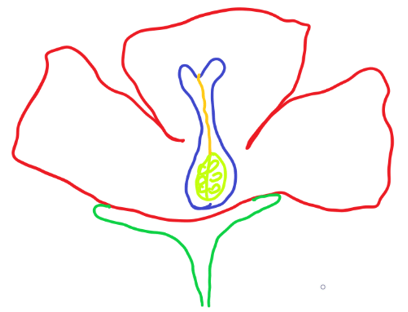This set of Class 12 Biology Chapter 2 Multiple Choice Questions & Answers (MCQs) focuses on “Sexual Reproduction in Flowering Plants”. These MCQs are created based on the latest CBSE syllabus and the NCERT curriculum, offering valuable assistance for exam preparation.
1. What is the reproductive unit in angiosperms?
a) Flowers
b) Stalk
c) Pedicel
d) Leaf
View Answer
Explanation: Flowers are the reproductive units of angiosperms. Angiosperms are flowering plants. Its inside the flowers that the male and female reproductive structures exist. Stamens in case of males and pistil in case of females.
2. Fruits and seeds are formed before fertilization.
a) True
b) False
View Answer
Explanation: Fruits and seeds are formed after fertilization. When the pollen grains fall on the stigma of the flower, fertilization process begins. When fertilization takes place, ovaries and ovules form parts of a fruit while the rest of the parts wither and fall off.
3. What are the four whorls of the flower arranged on?
a) Ovaries
b) Stem
c) Petals
d) Thalamus
View Answer
Explanation: The four whorls of the flower are arranged successively on a swollen end of a stalk or pedicel known as the thalamus or the receptacle. The receptacle gives rise to edible parts of the fruit.
4. Why are petals unique in shape, odor, color, etc.?
a) Attraction
b) Pollination
c) Survival
d) Protection
View Answer
Explanation: Flowers are unique in color, shape, odor, etc. for pollination. It is necessary to attract insects and animals for cross pollination and having sweet odor and attractive shapes and colors helps in attracting them. Pollination is a pre-requisite for fertilization.
5. What is a collection of sepals?
a) Calyx
b) Corolla
c) Petals
d) Style
View Answer
Explanation: Collection of sepals is known as calyx. Floral parts like calyx and various other parts help in the dispersal of fruits and seeds. Corolla is also known as petals. Style is a part of the gynoecium that helps in pollination.
6. Cross pollination offers variation.
a) True
b) False
View Answer
Explanation: Cross pollination is usually carried out by insects and animals or the environment. When insects land on the flower, the sticky pollen grains that carry the male gamete attach themselves to the insect body. When the same insect goes and lands on another flower, the pollen grains land on the stigma. This is cross pollination. Since fertilization is happening between male and female gametes of different flower, variation is seen which helps in adapting itself to the changing weather conditions.
7. What does the following picture depict?

a) Gynoecium
b) Androecium
c) Self-pollination
d) Cross-pollination
View Answer
Explanation: Flowers that are unisexual and have only female reproductive structures are known as gynoecium flowers. It consists of style, stigma and ovary. The part marked in blue is the stigma, the yellow line indicates the style and the light green part is the ovary.
8. Anthers and filaments form the _____
a) gynoecium
b) calyx
c) androecium
d) corolla
View Answer
Explanation: Androecium consists of the anthers and filaments. They are the male reproductive structures. Male gametes that are in pollen grains are on the anthers. Depending on the species, the stamens (anthers and filaments) may or may not protrude out of the flower.
9. What is self-pollination?
a) Pollens of a flower falling on another flower
b) Pollens of a flower falling on the stigma of the same flower
c) Pollens of the flower falling of the stigma of another flower of the same plant
d) Pollens of a flower falling on any flower
View Answer
Explanation: Self-pollination means fertilization by pollens of the same flower. When the pollens from the anther fall on the stigma of the same flower, the style carries the pollen to the ovaries. This is known as self-pollination.
10. What does the androecium produce?
a) Spores
b) Microspores
c) Egg
d) Ovules
View Answer
Explanation: Androecium collectively consists of the stamens, that is anthers and filaments. Anthers consists of the pollen grains. It’s within the pollen grains that the microspores are present. They form the male gamete.
More MCQs on Class 12 Biology Chapter 2:
- Chapter 2 – Sexual Reproduction in Flowering Plants MCQ (Set 2)
- Chapter 2 – Sexual Reproduction in Flowering Plants MCQ (Set 3)
- Chapter 2 – Sexual Reproduction in Flowering Plants MCQ (Set 4)
- Chapter 2 – Sexual Reproduction in Flowering Plants MCQ (Set 5)
- Chapter 2 – Sexual Reproduction in Flowering Plants MCQ (Set 6)
- Chapter 2 – Sexual Reproduction in Flowering Plants MCQ (Set 7)
- Chapter 2 – Sexual Reproduction in Flowering Plants MCQ (Set 8)
- Chapter 2 – Sexual Reproduction in Flowering Plants MCQ (Set 9)
- Chapter 2 – Sexual Reproduction in Flowering Plants MCQ (Set 10)
- Chapter 2 – Sexual Reproduction in Flowering Plants MCQ (Set 11)
- Chapter 2 – Sexual Reproduction in Flowering Plants MCQ (Set 12)
- Chapter 2 – Sexual Reproduction in Flowering Plants MCQ (Set 13)
- Chapter 2 – Sexual Reproduction in Flowering Plants MCQ (Set 14)
- Chapter 2 – Sexual Reproduction in Flowering Plants MCQ (Set 15)
- Chapter 2 – Sexual Reproduction in Flowering Plants MCQ (Set 16)
To practice all chapters and topics of class 12 Biology, here is complete set of 1000+ Multiple Choice Questions and Answers.
If you find a mistake in question / option / answer, kindly take a screenshot and email to [email protected]
- Check Class 12 - Biology Books
- Practice Class 12 - Physics MCQs
- Practice Class 11 - Biology MCQs
- Practice Class 12 - Mathematics MCQs
- Practice Class 12 - Chemistry MCQs
